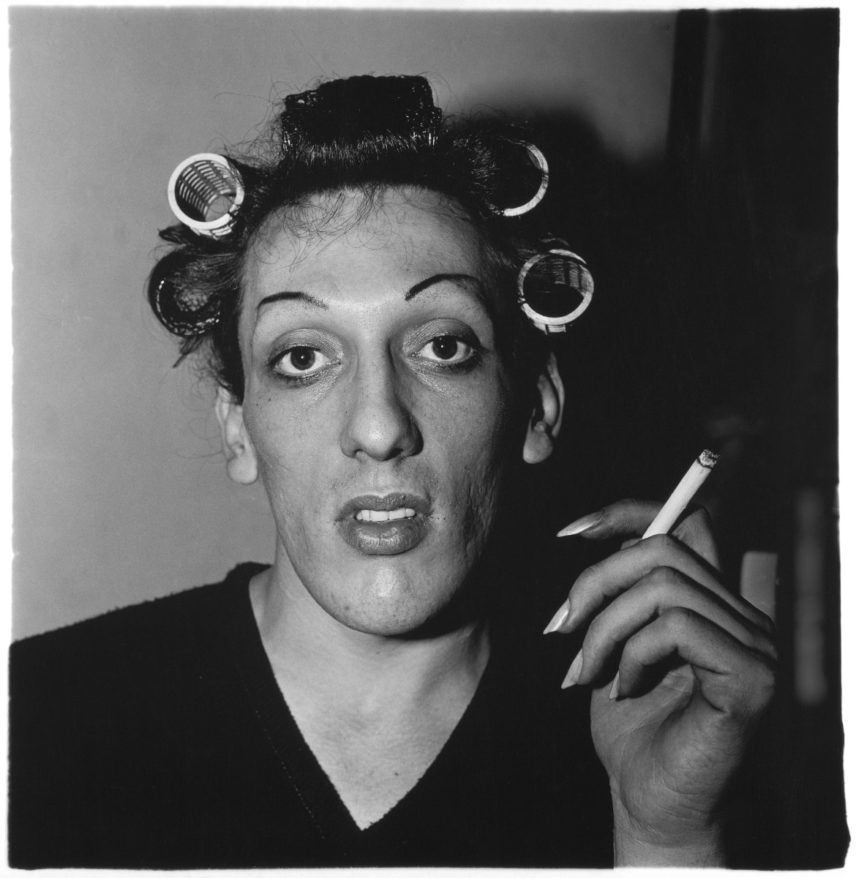Diane Arbus: The Humanist Photographer
A Young Man in Curlers at Home on West 20th Street, NYC
In the late 1950s, Diane Arbus began to capture photos of people she found on the streets of New York City. Most notably, the people Arbus caught on film were nudists, drag queens, and dwarfs, though she was also interested in middle class, conservative families. Arbus was famous for her photography of the so-called strange, yet her mission was not necessarily to shock. Instead, it was rather a documentation of people in their natural habitat, whether that be a morgue, a strip club, or a public park.
The value of Arbus's work lies in the fact that it brings visibility to people traditionally viewed as bizarre and communities that are oftentimes ignored, harassed, and oppressed. A question one asks themselves as they look at a naked woman is: how can men continue to deny the possibility of women's sexual freedom when their bodies are on such conventionally raw display? That was, I believe, a major motivation of Arbus: generating conversations and thoughts down avenues usually blocked for being deemed ungodly. For it sadly always seems that, in America and in society at large, it can be brutal to be different from the status quo. This was especially true in post-war 1950s America, a time when people wished to return to normalcy after World War II. This generated an intense force toward conformity, and social expectation felt as strong a pressure as written law. So for Arbus to show the general public people they feared or didn’t even know existed was extraordinary.
This photo, in particular, “A Young Man in Curlers at Home on West 20th Street, NYC” stands out to me, as well as to the people who saw it in 1966. One man went as far as to spit onto the photo, which was hung in the Museum of Modern Art in 1967. The man in the photo is a drag queen and is in the process of getting into full drag, speaking volumes of pride, confidence, and self acceptance; we can see in his eyes and in his posture that he’s unafraid and unbothered. Looking at this photo in the 60s, the masses asked, “How dare this man be proud or confident? How dare this man look straight into the camera with no fear?” The photograph caused outrage and, I believe, fear in the American people. This man demonized by society, seen as ill, as a monster, was still defiant, and he was not going to pity himself, for he saw nothing to pity. This kind of thinking became more and more prevalent in America throughout the 1960s, with movements like the Black Panthers being an example. People will not accept the brutal injustices against them when they decide to determine their own self-worth, rather than accepting how their oppressors define them. This is my interpretation of Arbus’s works; however, not everyone agrees.
Diane Arbus has been called an anti-humanist and sadistic woman who found joy in people's eccentricities. Yet, she has also been called a poet, whose eyes pierced the synthetic mirage of beauty and saw humanity.
Susan Sontag was an American writer, filmmaker, teacher, and political activist whose work predominantly centered on European cinema, photography, literature, and philosophy. In her book On Photography (1977) she said Arbus's subjects were “assorted monsters and borderline cases. . . . anti-humanist” and that her work “shows people who are pathetic, pitiable, as well as repulsive, but it does not arouse any compassionate feelings.” Sontag saw Arbus's work as mockery. She insists that Arbus's gaze is "based on distance, on privilege, on a feeling that what the viewer is asked to look at is really other.” Yet, Arbus’s photos do not emit shame, which is something I believe Sontag saw as being the only way to respectably perceive them. The viewer, Sontag believed, should look at these people with sympathy, but instead, some people would laugh and continue to stare with curiosity, fascinated by the face that stared back. Sontag saw this as a sadistic appreciation of a group of people who could be seen in no light other than pity.
On the contrary, Sandra S. Phillips, an American writer, and a senior curator of photography at the San Francisco Museum of Modern Art, proposes that “to cast Arbus in the role of a tragic figure who identified with freaks is to trivialize her accomplishment.” Phillips sees Arbus as “a great humanist photographer. " A humanist photographer is one who is interested in the documentation of the “common person”. A humanist photographer is trying to create in their simple (typically black and white) composition empathy, solidarity, and curiosity in connection with the subject. Arbus was not interested in setting the subject at ease, or in dramatifying their characteristics. I believe Arbus saw value in the truth of a narrative, and any added detail was based solely on the entertainment of others which was not the point of the photo. The point, as Arbrus herself said, is to recognize “the differences, those of birth, accident, choice, belief, predilection, inertia.” The challenge, she wrote, was “not to ignore them, not to lump them all together, but to watch them, to take notice, to pay attention.”
